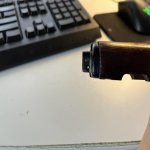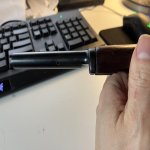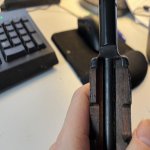Hi there,
Not sure if anyone can help with this. Recently I had to replace a handguard cover for my new Russian SKS that I just bought last week. I ordered a used wooden handguard and it arrived this morning. I put in the old piston tube and tried to align it to the metal cutouts. It only fits more or less one way, but when I tried fitting it together, I am just a wee bit short in terms of the pin hole alignments (and also the tube is not exactly flush against the back cover - it is very close as you can see in the photos). But as with anything else, close is no cigar. With it not exactly aligned it won't snap into place on my SKS anyway.
Clearly there is a fitment issue with a different wooden handguard. I wouldn't expect something parts like this produced in 1954 to have exact fitment and can be interchangeable, especially when one piece is wood and wouldn't be cut exactly the same.
Now, before anyone suggests I just give it a few whacks with the hammer, I already tried that - and I don't want to wreck my piston gas tube so I stopped hammering on both sides after a while. Presumably, and you can see this in the photos, the wood is flush on side side, but not quite on another. So no amount of hammering will really fix that.
I assume my next step is using a dremel to shave off some of the wood. The question is, where would you recommend?
I have included some photos I took - any suggestions are welcome. Thank you in advance for your feedback and assistance.






Not sure if anyone can help with this. Recently I had to replace a handguard cover for my new Russian SKS that I just bought last week. I ordered a used wooden handguard and it arrived this morning. I put in the old piston tube and tried to align it to the metal cutouts. It only fits more or less one way, but when I tried fitting it together, I am just a wee bit short in terms of the pin hole alignments (and also the tube is not exactly flush against the back cover - it is very close as you can see in the photos). But as with anything else, close is no cigar. With it not exactly aligned it won't snap into place on my SKS anyway.
Clearly there is a fitment issue with a different wooden handguard. I wouldn't expect something parts like this produced in 1954 to have exact fitment and can be interchangeable, especially when one piece is wood and wouldn't be cut exactly the same.
Now, before anyone suggests I just give it a few whacks with the hammer, I already tried that - and I don't want to wreck my piston gas tube so I stopped hammering on both sides after a while. Presumably, and you can see this in the photos, the wood is flush on side side, but not quite on another. So no amount of hammering will really fix that.
I assume my next step is using a dremel to shave off some of the wood. The question is, where would you recommend?
I have included some photos I took - any suggestions are welcome. Thank you in advance for your feedback and assistance.






Attachments
-
 2023-01-23 IMG_9642_resize.jpg42.3 KB · Views: 303
2023-01-23 IMG_9642_resize.jpg42.3 KB · Views: 303 -
 2023-01-23 IMG_9636_resize.jpg40.5 KB · Views: 305
2023-01-23 IMG_9636_resize.jpg40.5 KB · Views: 305 -
 2023-01-23 IMG_9637_resize.jpg39 KB · Views: 303
2023-01-23 IMG_9637_resize.jpg39 KB · Views: 303 -
 2023-01-23 IMG_9638_resize.jpg45.1 KB · Views: 301
2023-01-23 IMG_9638_resize.jpg45.1 KB · Views: 301 -
 2023-01-23 IMG_9639_resize.jpg48.3 KB · Views: 305
2023-01-23 IMG_9639_resize.jpg48.3 KB · Views: 305 -
 2023-01-23 IMG_9640_resize.jpg49.9 KB · Views: 302
2023-01-23 IMG_9640_resize.jpg49.9 KB · Views: 302










































































